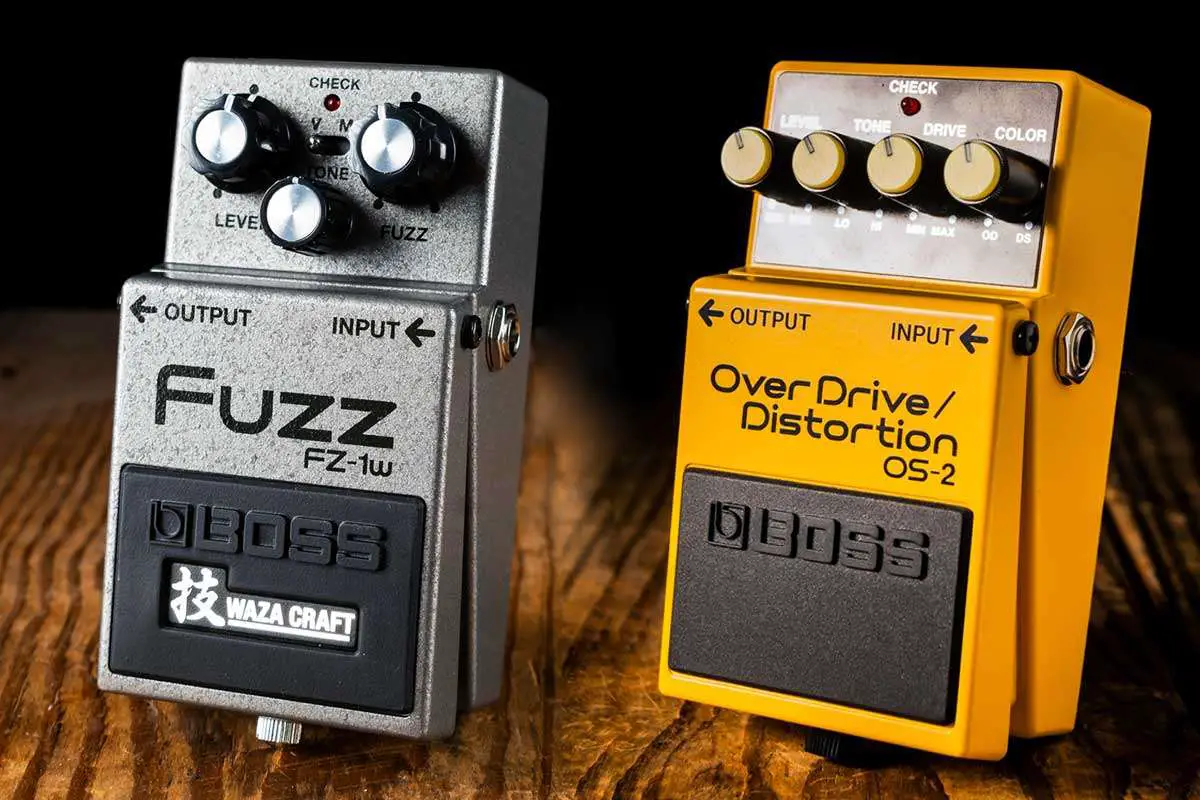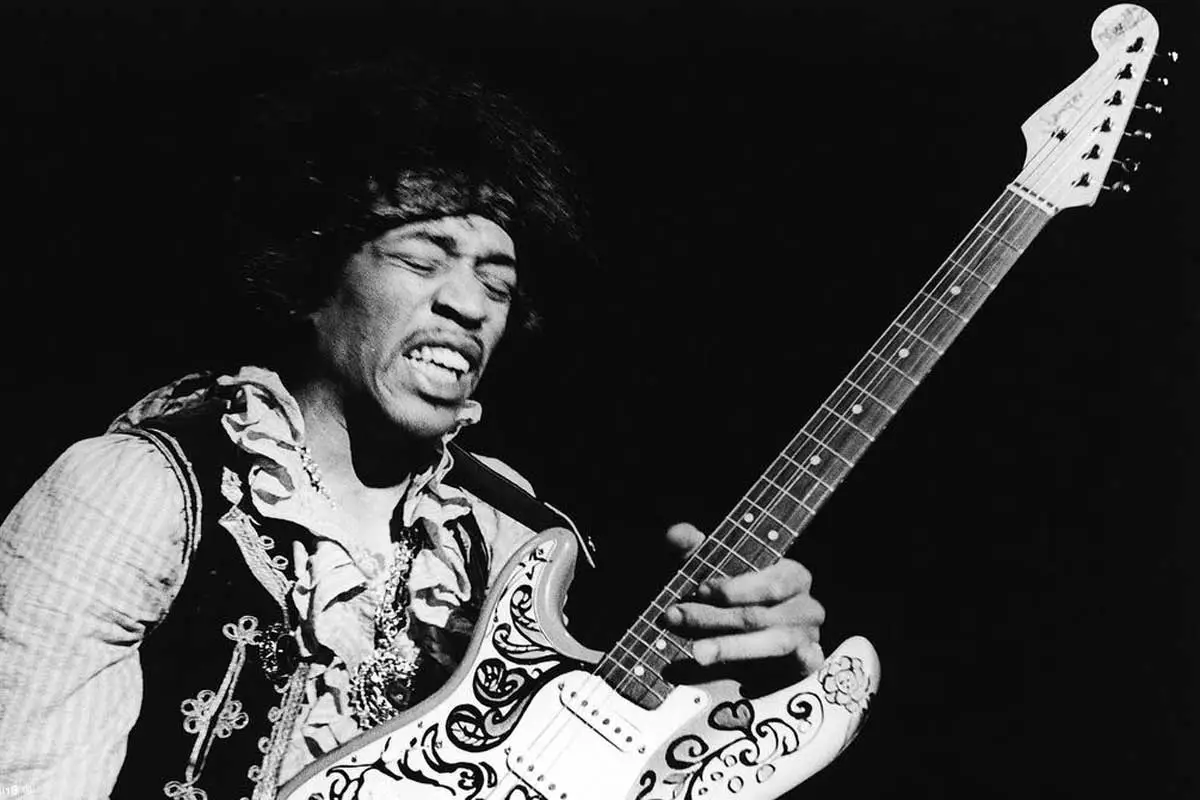When exploring the realm of electric guitar effects, you might encounter an array of terms that describe different types of sound modification. Among these, are two of the most iconic, easily confused, and often debated: Fuzz vs Distortion. Fuzz, known for its warm, woolly character, recreates the sound of a tube amplifier pushed to its limits, often associated with the psychedelic rock of the 1960s and 1970s. This effect can give your music a vintage flavor, with a sustain-rich tone that’s been embraced by countless guitar legends.
Distortion, on the other hand, is more aggressive and articulate when compared to fuzz. It provides a harder, more pronounced alteration of your guitar’s original sound, amplifying the signal until it clips, which results in a thicker, heavier tone. This effect is a staple in heavy metal and hard rock genres, where it’s used to achieve a powerful and intense sound. While overdrive might be mentioned in the same breath, think of it as a subtler cousin to distortion; it offers a smooth, clipped tone similar to that of a tube amp being overdriven naturally.
Understanding the nuanced differences between these effects can help you craft your unique guitar tone, whether you’re looking for the chaotic splendor of a classic fuzz circuit or the precise bite of a high-gain distortion pedal. Each effect can dramatically change the character of your music, turning a clean signal into something complex and evocative. As you experiment, you’ll discover how these tools can expand your sonic palette.

Fuzz Effects
When you explore the realm of guitar tones, the fuzz effect stands out with its warm, woolly, and distorted character. This section walks you through its history, the tonal characteristics that define fuzz, and some iconic pedals that helped shape music as we know it.
History of Fuzz
The origin of fuzz effects can be traced back to the early 1960s, with the first commercially available fuzz pedal being the Maestro FZ-1 Fuzz-Tone, released in 1962. The use of fuzz became widely recognized through its iconic sound on the Rolling Stones’ hit “(I Can’t Get No) Satisfaction“. Not long after, Jimi Hendrix began experimenting with fuzz effects, cementing its status in rock history.
Characteristics of Fuzz
Fuzz effects are characterized by their creation of a rich, square wave distortion by clipping the guitar’s signal, often through the use of transistors. The result is a harmonically rich, sustaining sound that can range from smooth to aggressive. Unlike other forms of distortion, fuzz maintains a distinct, buzzy character even when playing chords, making it a favorite for genres craving texture, such as psychedelic rock, exemplified by Smashing Pumpkins.
Iconic Fuzz Pedals
Numerous fuzz pedals have achieved legendary status over the years:
- Fuzz Face: Favored by Jimi Hendrix, this pedal is known for its distinctive round shape and warm, smooth tones.
- Big Muff Pi: Popularized by bands like Smashing Pumpkins, it’s renowned for its sustain and rich harmonic content.
- ZVEX Fuzz Factory: Although a newer addition, it offers a wide range of sounds and has itself carved out a spot as an iconic fuzz device.
These pedals have not just contributed to individual artist’s sound, but have collectively shaped a sonic movement.
Distortion Effects
Distortion effects shape the sound of your electric guitar, adding richness, intensity, and character. In this section, you’ll learn about different types of distortion, their use across music genres, and the pedals that have become famous for achieving these iconic sounds.
Types of Distortion
Soft Clipping: This produces a warmer, smoother distortion by rounding off the audio signal peaks. It’s subtler than the alternative.
Hard Clipping: Involves more aggressively trimming the peaks of the audio signal, which results in a bolder, more intense distortion.
- Fuzz: A form of extreme distortion where the signal is squared off, creating a sustain-heavy and buzzy texture.
- Overdrive: Simulates the warm sound of a tube amp being pushed to its limits, with a gentle form of distortion.
Distortion in Different Music Genres
Rock: Here, distortion is the backbone, providing the grit and aggression in everything from rhythm to high-flying solos. Bands like Metallica carved their sound with a heavy use of distortion.
Punk: It’s raw, fast, and loud. Distortion in punk strips down to the essentials, giving it an edgy, confrontational feel.
- Metal: Seeks a heavier, more aggressive distortion, using hard clipping to achieve the intensity required for its thunderous, darker tones.
Famous Distortion Pedals
- Big Muff: Renowned for its rich, creamy fuzz, it has been a mainstay on many pedalboards across various genres.
- Boss DS-1: A classic pedal that offers a reliable, consistent distortion sound used in countless rock and punk albums.
- Ibanez Tube Screamer: Favored for its overdrive, it’s known to enhance the warmth and natural dynamics of guitars.
As you explore the world of distortion, these names and terms will guide you toward crafting your unique sound.
Overdrive Effects
When you are looking to add some warmth and natural-sounding distortion to your guitar play, overdrive effects are your go-to solution. These emulate the sound of pushing a tube amp just to the brink of breaking up, providing a subtle, dynamic form of distortion.
Defining Overdrive
Overdrive occurs when your tube amp’s vacuum tubes are driven past their normal operating point, resulting in soft clipping of the audio signal. This soft clipping produces a warm, and nuanced distortion. Unlike fuzz or heavy distortion, overdrive preserves the core of your guitar’s tone, providing a sound often associated with blues, rock, and country genres.
Overdrive Pedals and Their Uses
Overdrive Pedals serve to mimic the natural overdrive of a cranked tube amplifier at more manageable volume levels. These pedals are a staple for blues guitarists who seek that classic, expressive sound without having to push their amps to maximum.
A famous example of an overdrive pedal is the Ibanez Tube Screamer, renowned for its creamy and articulate tonal quality. Another noteworthy pedal is the Klon Centaur; despite its rarity, it is revered for its transparent sonic enhancement. Overdrive pedals are versatile – they can be used as a boost in front of an already overdriven amp or as the primary source of distortion with a clean amp setting.
The Difference Between Fuzz, Distortion, and Overdrive
As a guitarist, understanding the subtleties of your tone is crucial. Fuzz, distortion, and overdrive each stem from unique signal processing techniques that define their distinctive sounds.
Circuitry and Clipping
Fuzz pedals, like the Fuzz Factory Germanium Fuzz, heavily clip your signal, producing a nearly square waveform which results in a rich, saturated tone unthinkable in the natural world. On the contrary, distortion pedals clip your signal less aggressively, creating a balance of harmonics and sustain. Overdrive, the mildest of the trio, slightly pushes your signal just beyond its threshold, enhancing warmth and preserving the nuances of your guitar’s natural sound.
Practical Use on Pedalboards
On your pedalboard, fuzz, like a wild beast, can cause havoc if not tamed properly; it demands attention and often functions best at the beginning of your signal chain. Distortion pedals are more versatile and can fit comfortably amidst other effects, even giving a boost when needed. Overdrive pairs wonderfully after reverb or before it, serving as a signal booster or to warm up your tone.
Sound Shaping in a Mix
In a mix, fuzz dramatically alters the texture of your guitar, making it stand out or even dominate. Distortion is your go-to for a more aggressive edge that cuts through but maintains musical cohesion. Overdrive subtly shapes your sound, enhancing body and sustain, ensuring your guitar sits well with other instruments without overpowering them.
Guitarists and Their Signature Sounds
When you explore the world of electric guitar sounds, you’ll find that the use of fuzz, distortion, and overdrive has been pivotal in defining the signature tones of many legendary guitarists. From the classic rock riffs of Jimmy Page to the heavy metal growls heard in bands like Lamb of God, these effects have shaped music as we know it.
Influence of Fuzz, Distortion, and Overdrive
Fuzz, distortion, and overdrive are three pillars of guitar tone that have helped musicians craft their unique sound. Fuzz generally gives a warm and wooly texture, creating a vintage vibe that is often associated with 60s rock bands. Taking it up a notch, distortion provides a more aggressive and sustained growl which is a mainstay in genres like metal music. Meanwhile, overdrive creates a smooth, clipped sound reminiscent of tube amplifiers being pushed to their limits, a technique popularized by blues and rock guitarists.
- Fuzz:
- Characteristic Artists: Jimi Hendrix, Keith Richards
- Distortion:
- Characteristic Artists: James Hetfield (Metallica), Mark Morton (Lamb of God)
- Overdrive:
- Characteristic Artists: B.B. King, Stevie Ray Vaughan
Jimmy Page, for instance, often leveraged a blend of these effects to create the iconic Led Zeppelin sound that has influenced countless rock bands.
Legendary Guitarist Rigs
Each guitarist’s set-up is a carefully curated ecosystem, designed to produce their signature sound. Jimmy Page’s use of Gibson Les Paul guitars through a cranked Marshall amplifier is a benchmark for aspiring rock guitarists. A straightforward rig, yet the nuances in his use of fuzz and overdrive, have cemented a legacy that’s instantly recognizable.
- Jimmy Page (Led Zeppelin):
- Guitar: Gibson Les Paul
- Amp: Marshall Super Lead 100
- Notable Effects: Sola Sound Tone Bender, Vox Wah, MXR Phase 90
In metal music, the focus is often on high-gain amps and detailed pedalboards to achieve a precise level of distortion. Guitarists like Mark Morton from Lamb of God employ complex arrangements of pedals to capture the band’s signature sound.
- Mark Morton (Lamb of God):
- Guitar: Jackson Dominion Signature
- Amp: Mesa Boogie Mark V
- Notable Effects: TC Electronic Polytune, Ibanez Tube Screamer, MXR Smart Gate
Doom metal band YOB, known for their thundering riffs and massive volume, creates their sound through an expansive array of pedals that sculpt the fuzz and distortion into a sonic landscape of their own.
- Mike Scheidt (YOB):
- Guitar: Travis Bean TB500
- Amp: Sunn Model T
- Notable Effects: Boss MT-2 Metal Zone, Electro-Harmonix Memory Man, EHX Holy Grail Reverb
The guitar rigs of these artists are not just about the gear but also about how it’s played. Your touch, your technique, and how you manipulate the strings and controls ultimately dictate the final sound that emerges.
Choosing the Right Effect for Your Style
When you select a guitar effect, you’re choosing the voice of your instrument. It’s critical to match your pedals with the style of music you play and the sound you aim to achieve.
Considerations for Genre and Technique
Your musical genre is a decisive factor in choosing between fuzz, distortion, or overdrive. For example, if you’re into the rough, cutting sounds of punk or the classic edge characteristic of blues guitarists like The Rolling Stones, a fuzz pedal might be your go-to choice. On the other hand, for the aggressive, saturated tones suited to metal, a high-gain distortion pedal can give you that relentless power.
Technique-wise, you must also consider your playing style. Overdrive, with its more subtle and warm sound, is excellent for dynamic playing where the intensity of your picking directly affects the level of distortion. In contrast, a fuzz pedal reacts more drastically to your playing nuances, sometimes obscuring intricate picking patterns.
Combining Effects for Unique Sounds
You can mix and experiment with different types of pedals to create unique sounds:
- Fuzz into Overdrive: Achieve a thick, sustained tone by stacking a fuzz’s raw edge beneath the clarity and warmth of an overdrive.
- Distortion into Overdrive: For a smooth yet aggressive tone that doesn’t get too fuzzy, place a distortion pedal before overdrive.
Create your signature sound by understanding and blending these effects to match your personal style and the requirements of the genres you delve into.
The Impact of Effects on Music Culture
The use of effects like fuzz and distortion has profoundly shaped the soundscape of popular music, particularly in genres like rock and metal. These elements have become a cornerstone of guitar music.

Effects in Popular Music
Guitar effects have been pivotal in defining the sonic character of rock. From Jimi Hendrix’s pioneering use of fuzz, which carved a psychedelic edge into songs, to the heavy, saturated distortion that characterizes metal, these tones have become emblematic of their respective genres. For instance, the Deftones, recognized for their contribution to the nu-metal scene, leverage a range of effects to create their distinctive atmospheric layers, while Slipknot employs aggressive distortion to complement their intense performance style.
- Pioneering Use: Jimi Hendrix with fuzz effects
- Atmospheric Layers: Deftones using a variety of effects
- Aggressive Tones: Distortion in Slipknot’s music
Innovation and the Future of Guitar Effects
The innovation in guitar effects is ongoing, reflecting shifts in technology and taste within modern music culture. Modern bands continue to push boundaries, with genres like doom metal often relying on the massive, wall-of-sound impact of fuzz and distortion to convey a sense of weighty somberness. As these effects evolve, so does the musical expression they enable, hinting at an expansive future where the integration of traditional effects and digital technology continues to redefine what you recognize as the sound of a guitar.
- Wall-of-Sound: Doom metal’s extensive use of fuzz
- Digital Integration: Modern effects combining with technology
Cultural Impact and Notable Performances
When you explore the realm of guitar effects, the culturally significant contributions of fuzz and distortion become apparent through pivotal performances and genre-defining albums. Let’s uncover how these effects paved the way for groundbreaking moments in music history.

Historical Concerts and Albums
Jimi Hendrix‘s use of fuzz in his Monterrey Pop Festival performance—especially his rendition of “Wild Thing”—has become an iconic example of how a particular effect can define a moment. The aggressive, yet soulful, use of fuzz helped to set a new standard for what was possible on the electric guitar. His impact was so profound that listening to tracks like “Foxy Lady” gives you a glimpse into the psychedelic era without needing any other context. Dive into the Hendrix experience through the lens of progressive rock and psychedelic coding.
Moving from the light to the heavy, Metallica‘s distortion-driven performances and albums like “Master of Puppets” showcased the effect’s potential to enshroud melodies in power and darkness. Their use of distortion carved out a significant space for thrash metal, shaping the genre for years to come.
Effects Usage in Sub-genres
Fuzz and distortion are not just effects—they are tones that have birthed entire sub-genres. In the realm of stoner and doom metal, bands like Sleep have leveraged down-tuned guitars and thick layers of fuzz to create their signature sound—a sludgy and immersive auditory experience evoking the sensation of wading through molten lava. Discover more about this cultural thread through books examining the Pedal Culture.
Bands such as Queens of the Stone Age (QOTSA) and Smashing Pumpkins found their own unique applications of fuzz and distortion. QOTSA’s album “Songs for the Deaf” features a gritty tone that cuts—with precision—through the mix, while Smashing Pumpkins’ “Siamese Dream” album is a compelling exploration into layers of dense, fuzzy soundscapes.
Sonic Youth took distortion to a new frontier, treating it as a tool for sculpting sound as much as a means of amplification. This inventive approach redefined what could be achieved with feedback and noise, and challenged the traditional boundaries of music.
Slipknot is another band that harnesses the raw energy of distortion. Their visceral performances capture the immediacy and impact of the effect, propelling their blend of metal to new levels of intensity.
These artists and genres underline the transformative effect that deployment of fuzz and distortion can have, underlining your journey through sound with memorable musical legacies.
